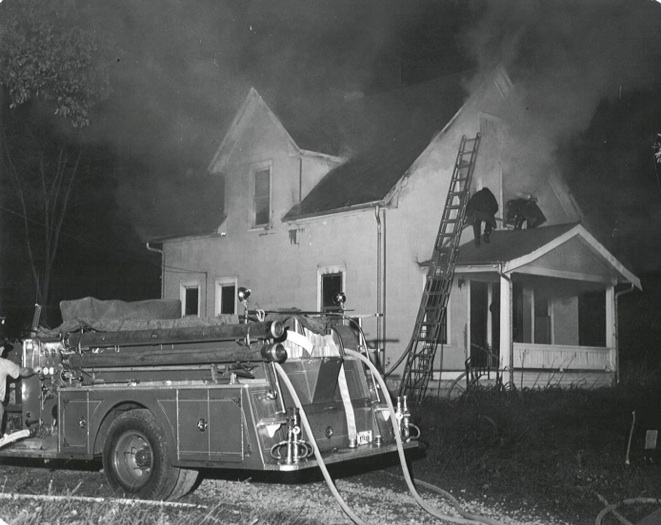Fire Safety

Perhaps it’s because my brother is a volunteer fireman, or perhaps it’s because I’ve taught a lot of pysanka classes, but I feel quite strongly about the need to practice meticulous fire safety. Pysanky, when made in the traditional manner, utilize candles to heat and remove the wax. And, any time candles are present, the risk of fire is present, too.
What can you do to minimize the risk of conflagration?
Work Area: It’s very important to keep your work area free of loose papers and other flammable materials. I keep a few sheets of paper towel flat on the table as a work surface, but otherwise try to keep the area clear. I leave any drying papers near the dyes, and do not bring them back to my work area.
As is often the case, my caution is due to previous experience–namely, the Great Fuzz Fire of ’07, when my niece set fire to the dining room table. (Her dining room, thankfully.) The fire began in a pile of paper towels. It was quickly extinguished, but could have caused much more trouble.
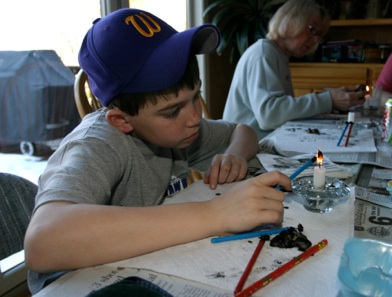
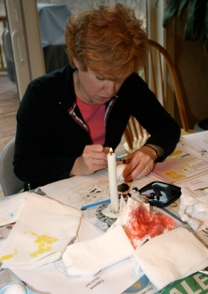
Good (left) and Bad (right) approaches to workspace fire safety
Matches: Matches are a fire hazard for several reasons. A spent match must be discarded very carefully. If you throw one in the trash, and the match hasn’t cooled completely, you might easily set the trash on fire. And matches are very tempting to children, many of whom have a fascination with fire and love to play with them.
When teaching pysankarstvo, I use a lighter, preferably one with a long tube (see below). This has three advantages. First, when working with children, I keep this lighter in my possession, and only allow other adults to light the candles. Second, no matches means no risk of setting anything on fire accidentally with a discarded match. And, lastly, by not having to get as close to the candle to light it, I have less of a chance of setting myself (clothes, hair) on fire with a neighboring lit candle. (Don’t laugh; it happens. Although it hasn’t happened to me........yet.)
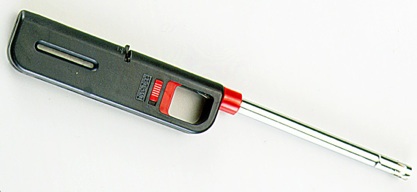
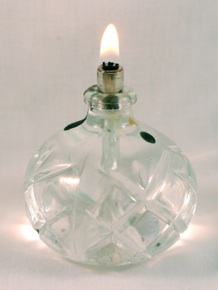
And I have often smelled the scent of singing hair, when girls (usually, but not exclusively) with long, unruly hair get a bit too close to the flame while working. It is not a pleasant smell, but usually the damage is minor.
(Note: when buying these long lighters, keep an eye out for the refillable type. After all, love and dyes may fade with time, but plastic is forever.....)
Oil Lamps: These are the ideal heat source when making drop-pull pysanky, as, unlike candles, their height does not change as they burn.
Sadly, they can be quite dangerous–jostling them will cause the oil to spill, and spilled oil can easily catch on fire. While I find these lamps very useful, I avoid using them when there are children around, or when I am working at a crowded table.
It should go without saying that young children should NOT be allowed to use oil lamps, even with supervision.

But care must be taken when burning candles. The National Fire Protection Association report that candles are the 4th leading cause of house fires. During 2005, an estimated 15,600 home structure fires started by candles were reported to local fire departments in the USA. These fires resulted in an estimated 150 civilian deaths, 1,270 civilian injuries and an estimated direct property loss of $539 million.
Mind you, many of these were started by unattended “decorative” candles, but it still pays to be careful. According to fire experts, the bulk of candle-fire incidents are due to consumer inattention to basic fire safety or to the misuse of candles.
Some safety tips (to help keep you from becoming another fire statistic) from the National Candle Association:
 Always keep a burning candle within sight. Extinguish all candles when leaving a room or before going to sleep.
Always keep a burning candle within sight. Extinguish all candles when leaving a room or before going to sleep. Never burn a candle on or near anything that can catch fire. Keep burning candles away from furniture, drapes, bedding, carpets, books, paper, flammable decorations, etc.
Never burn a candle on or near anything that can catch fire. Keep burning candles away from furniture, drapes, bedding, carpets, books, paper, flammable decorations, etc. Keep candles out of the reach of children and pets. Do not place lighted candles where they can be knocked over by children, pets or anyone else.
Keep candles out of the reach of children and pets. Do not place lighted candles where they can be knocked over by children, pets or anyone else. Trim candlewicks to ¼ inch each time before burning. Long or crooked wicks cause uneven burning and dripping.
Trim candlewicks to ¼ inch each time before burning. Long or crooked wicks cause uneven burning and dripping. Always use a candleholder. The holder should be heat resistant, sturdy and large enough to contain any drips or melted wax. (See photo above left)
Always use a candleholder. The holder should be heat resistant, sturdy and large enough to contain any drips or melted wax. (See photo above left) Keep the wax pool free of wick trimmings, matches and debris at all times.
Keep the wax pool free of wick trimmings, matches and debris at all times. Keep burning candles away from drafts, vents, ceiling fans and air currents. This will help prevent rapid, uneven burning, and avoid flame flare-ups and sooting. Drafts can also blow lightweight curtains or papers into the flame where they could catch fire.
Keep burning candles away from drafts, vents, ceiling fans and air currents. This will help prevent rapid, uneven burning, and avoid flame flare-ups and sooting. Drafts can also blow lightweight curtains or papers into the flame where they could catch fire. Don't burn a candle all the way down. Extinguish the flame if it comes too close to the holder or container.
Don't burn a candle all the way down. Extinguish the flame if it comes too close to the holder or container.  Never touch a burning candle or move a votive or container candle when the wax is liquid.
Never touch a burning candle or move a votive or container candle when the wax is liquid. Never extinguish candles with water. The water can cause the hot wax to splatter.
Never extinguish candles with water. The water can cause the hot wax to splatter. Extinguish a candle if it smokes, flickers repeatedly, if it sputters wildly or the flame becomes too high. The candle isn't burning properly and the flame isn't controlled. Let the candle cool, trim the wick, then check for drafts before re-lighting. If it continues to misbehave, toss it out .
Extinguish a candle if it smokes, flickers repeatedly, if it sputters wildly or the flame becomes too high. The candle isn't burning properly and the flame isn't controlled. Let the candle cool, trim the wick, then check for drafts before re-lighting. If it continues to misbehave, toss it out . Make sure a candle is completely extinguished and the wick ember is no longer glowing before leaving the room.
Make sure a candle is completely extinguished and the wick ember is no longer glowing before leaving the room.
Lighting Candles: Candles are most safely lit with a match or a lighter. However, it can be more convenient, especially during classes, to light a candle from an already lit candle. If you do so, remember to always hold the unlit one to the lit one. Tipping a lit candle is dangerous, as you can spill molten wax or, worse, the spilled wax can catch fire from the flame and then spread fire where it lands.

Wooden styluses: The main problem with wooden styluses is that wood burns. All wooden styluses get charred over time, as in the photo below, but it is still important to try to minimize this. Charred wood can flake off, and this causes the tip to become destabilized and wobbly.

Only the metal parts of the stylus–the tip or the opening of the metal cone–and not the entire end of the stylus, should actually be heated in the flame.

If you are not careful, the wooden handle can catch on fire. It can usually be blown out quite easily, but sometimes students can freak out, drop them, and cause the fire to spread to other flammables.
Removing Wax: the process of removing wax form an egg is unlikely to start a fire, but can cause burns. Small children should not be allowed to remove wax from eggs, even with adult supervision. All others should be supervised. Adult student should be supervised the first time they do it in a class, at least initially.
This is less of a concern with full eggs, but if you hold the egg incorrectly, full or empty, with your fingers too close to the flame, you can easily burn yourself......and often drop the egg and break it.
Empty eggs are more of a concern for burns. The white and yolk act as a heat sink; when you hold the egg near the flame to remove wax, the excess heat is absorbed by the liquid matter inside. When there is no white and yolk, the heat is absorbed only by the shell, and it can get very hot quite quickly. It may be necessary to “rest” the egg for a few minutes to let the shell cool down enough for it to be held safely.
REMEMBER

CAN PREVENT WORK SPACE FIRES!
Back to Main Preparations page
Back to Main Pysankarstvo page
Search my site with Google
Be careful!
